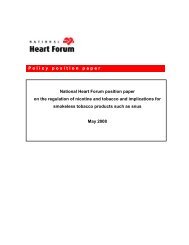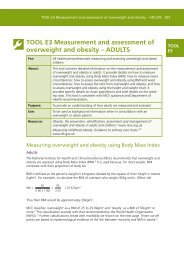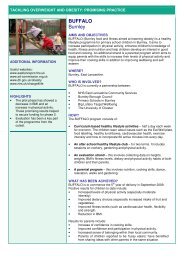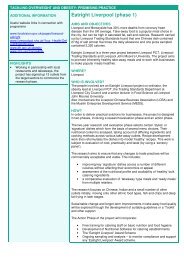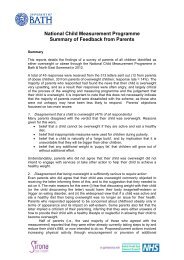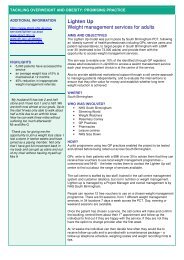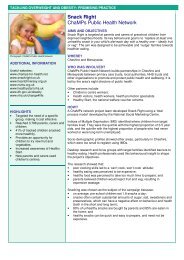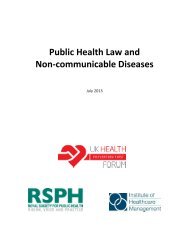The Challenge of Non-Communicable Diseases and Road Traffic ...
The Challenge of Non-Communicable Diseases and Road Traffic ...
The Challenge of Non-Communicable Diseases and Road Traffic ...
You also want an ePaper? Increase the reach of your titles
YUMPU automatically turns print PDFs into web optimized ePapers that Google loves.
38 <strong>The</strong> <strong>Challenge</strong> <strong>of</strong> <strong>Non</strong>-communicable <strong>Diseases</strong> <strong>and</strong> <strong>Road</strong> <strong>Traffic</strong> Injuries in Sub-Saharan Africa<br />
TABLE 9: Population-Level Priority Interventions for NCDs Relevant to SSA (by Incremental Cost-Effectiveness)<br />
Area Interventions Status Cost-effectiveness<br />
Tobacco<br />
Alcohol<br />
Diet<br />
Physical<br />
Activity<br />
Injuries<br />
(road<br />
traffic)<br />
Raise prices by raising taxes on tobacco BEST BUY Very cost-effective<br />
Inform on harm from use <strong>and</strong> benefits <strong>of</strong> quitting BEST BUY Very cost-effective<br />
Enforce bans on tobacco advertising BEST BUY Very cost-effective<br />
Protect people from tobacco smoke BEST BUY Very cost-effective<br />
Offer counseling to smokers GOOD BUY Quite cost-effective<br />
Restrict access to retailed alcohol BEST BUY Very cost-effective<br />
Enforce bans on alcohol advertising BEST BUY Very cost-effective<br />
Raise prices by raising taxes on alcohol BEST BUY Very cost-effective<br />
Enforce drink-driving laws (breath-testing) GOOD BUY Quite cost-effective<br />
Offer brief advice for hazardous drinking GOOD BUY Quite cost-effective<br />
Promote reduced salt intake BEST BUY Very cost-effective<br />
Promote replacing <strong>of</strong> trans-fat with polyunsaturated fat BEST BUY Very cost-effective<br />
Promote public awareness about diet<br />
Restrict marketing to children <strong>of</strong> nutrient-poor food <strong>and</strong> beverages,<br />
food high in salt, fats, <strong>and</strong> sugar<br />
BEST BUY in<br />
combination<br />
GOOD BUY<br />
Very cost-effective<br />
Very cost-effective*<br />
Replace saturated fat with unsaturated fat GOOD BUY Very cost-effective*<br />
Manage food taxes/subsidies to discourage consumption <strong>of</strong> unhealthy<br />
foods <strong>and</strong> encourage consumption <strong>of</strong> healthier options<br />
Promote physical activity (mass media)<br />
GOOD BUY<br />
BEST BUY in<br />
combination<br />
Very cost-effective*<br />
Very cost-effective<br />
Legislation <strong>and</strong> enforce bicycle helmet use, 80% coverage BEST BUY Very cost-effective<br />
Speed cameras + breath testing + motorcycle helmets, 80% coverage<br />
Seat belts + motorcycle helmets + bicycle helmets + speed cameras<br />
+ breath testing, 80% coverage<br />
Source: Authors, based on [12, 64, 232-234]<br />
* Needs more studies, not yet assessed globally, therefore given only ‘good buy’ status.<br />
BEST BUY in<br />
combination<br />
BEST BUY in<br />
combination<br />
Very cost-effective<br />
Very cost-effective<br />
<strong>The</strong>re have been a number <strong>of</strong> efforts in recent years<br />
to identify effective <strong>and</strong> cost-effective interventions<br />
for NCD <strong>and</strong> RTI prevention [12, 226-229], <strong>and</strong> on<br />
how much a combined approach would cost [230-<br />
231]. Table 9 draws together a list <strong>of</strong> ‘best buys’ <strong>and</strong><br />
‘good buys’ 7 for low- <strong>and</strong> middle-resourced countries,<br />
countries with high adult <strong>and</strong> child mortality,<br />
<strong>and</strong> SSA. While this list does not take into account<br />
7 WHO defines ‘best buys’ as “highly cost effective, cheap, feasible, <strong>and</strong> culturally<br />
acceptable to implement”, <strong>and</strong> ‘good buys’ as “effective interventions<br />
that provide good value for money but which may cost more or generate less<br />
health gain”. An intervention is defined as very or highly cost-effective if the<br />
cost <strong>of</strong> generating an extra year <strong>of</strong> healthy life (equivalent to averting one<br />
DALY) is below the average annual income or gross domestic product (GDP)<br />
per capita (I$2 000); <strong>and</strong> ‘quite cost-effective’ if less than three times per<br />
capita GDP per DALY. Interventions that are effective but which are three-fold<br />
more costly than per capita GDP per DALY are considered ‘less cost-effective’<br />
or ‘not cost-effective’, depending on source, <strong>and</strong> are not included in this list.<br />
Main data sources for globally applicable, cost-effectiveness estimates are<br />
the Disease Control Priorities project <strong>and</strong> WHO-CHOICE project.<br />
the diversity or specificity <strong>of</strong> individual country contexts,<br />
it does provide a broad indication <strong>of</strong> value for<br />
money, <strong>and</strong> can form the basis <strong>of</strong> an evidence-based<br />
policy package [12, 64].<br />
In practice, ‘best buys’ or ‘good buys’ <strong>and</strong> other<br />
cost-effective interventions are not always pursued<br />
[235]. This may be because <strong>of</strong> the reasons referred to<br />
above such as difficulties related to political will, social<br />
preferences, or vested interests. It may also be that<br />
most are based on cost-effectiveness studies derived<br />
mainly from high-income countries or on their implementation<br />
in ideal conditions rather than SSA realities.<br />
In the sections that follow, examples are given<br />
where these interventions have been successfully implemented<br />
in LMIC <strong>and</strong> particularly in Africa.



